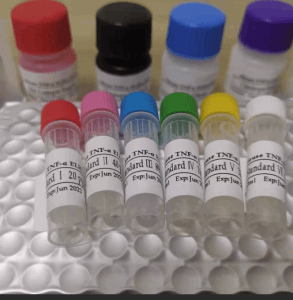产品编号YS-0078R
英文名称Rabbit Anti-TNF alpha antibody
别 名Tumor necrosis factor-α; TNFα; TNF-α; TNFalpha; APC1; Cachectin; DIF; Differentiation inducing factor; Macrophage cytotoxic factor; MCF; Necrosin; TNF a; TNF-alpha; TNF; TNF Macrophage Derived; TNF Monocyte Derived; TNF Superfamily Member 2; TNFA; TNFSF2; Tumor necrosis factor ligand superfamily member 2; Tumor Necrosis Factor Precurso; Tumour Necrosis Factor Alpha; TNFA_HUMAN.
抗体来源Rabbit
克隆类型Polyclonal
交叉反应Human,Mouse (predicted: Pig,Dog,Horse)
产品应用WB=1:500-2000,Flow-Cyt=1ug/Test
not yet tested in other applications.
optimal dilutions/concentrations should be determined by the end user.
理论分子量17/26kDa
检测分子量17.5/26 kD
细胞定位细胞膜 分泌型蛋白
性 状Liquid
浓 度1mg/ml
免 疫 原KLH conjugated synthetic peptide derived from human TNF alpha: 86-150/233
亚 型IgG
纯化方法affinity purified by Protein A
缓 冲 液0.01M TBS (pH7.4) with 1% BSA, 0.02% Proclin300 and 50% Glycerol.
保存条件Shipped at 4℃. Store at -20℃ for one year. Avoid repeated freeze/thaw cycles.
注意事项This product as supplied is intended for research use only, not for use in human, therapeutic or diagnostic applications.
PubMedPubMed
产品介绍This gene encodes a multifunctional proinflammatory cytokine that belongs to the tumor necrosis factor (TNF) superfamily. This cytokine is mainly secreted by macrophages. It can bind to, and thus functions through its receptors TNFRSF1A/TNFR1 and TNFRSF1B/TNFBR. This cytokine is involved in the regulation of a wide spectrum of biological processes including cell proliferation, differentiation, apoptosis, lipid metabolism, and coagulation. This cytokine has been implicated in a variety of diseases, including autoimmune diseases, insulin resistance, psoriasis, rheumatoid arthritis ankylosing spondylitis, tuberculosis, autosomal dominant polycystic kidney disease, and cancer. Mutations in this gene affect susceptibility to cerebral malaria, septic shock, and Alzheimer disease. Knockout studies in mice also suggested the neuroprotective function of this cytokine. [provided by RefSeq, Aug 2020]
Function:
Cytokine that binds to TNFRSF1A/TNFR1 and TNFRSF1B/TNFBR. It is mainly secreted by macrophages and can induce cell death of certain tumor cell lines. It is potent pyrogen causing fever by direct action or by stimulation of interleukin-1 secretion and is implicated in the induction of cachexia, Under certain conditions it can stimulate cell proliferation and induce cell differentiation.
The TNF intracellular domain (ICD) form induces IL12 production in dendritic cells.
Subunit:
Homotrimer. Interacts with SPPL2B.
Subcellular Location:
Cell membrane; Single-pass type II membrane protein.
Tumor necrosis factor, membrane form: Membrane; Single-pass type II membrane protein.
Tumor necrosis factor, soluble form: Secreted.
C-domain 1: Secreted.
C-domain 2: Secreted.
Post-translational modifications:
The soluble form derives from the membrane form by proteolytic processing. The membrane-bound form is further proteolytically processed by SPPL2A or SPPL2B through regulated intramembrane proteolysis producing TNF intracellular domains (ICD1 and ICD2) released in the cytosol and TNF C-domain 1 and C-domain 2 secreted into the extracellular space.
The membrane form, but not the soluble form, is phosphorylated on serine residues. Dephosphorylation of the membrane form occurs by binding to soluble TNFRSF1A/TNFR1.
O-glycosylated; glycans contain galactose, N-acetylgalactosamine and N-acetylneuraminic acid.
DISEASE:
Genetic variations in TNF are a cause of susceptibility psoriatic arthritis (PSORAS) [MIM:607507]. PSORAS is an inflammatory, seronegative arthritis associated with psoriasis. It is a heterogeneous disorder ranging from a mild, non-destructive disease to a severe, progressive, erosive arthropathy. Five types of psoriatic arthritis have been defined: asymmetrical oligoarthritis characterized by primary involvement of the small joints of the fingers or toes; asymmetrical arthritis which involves the joints of the extremities; symmetrical polyarthritis characterized by a rheumatoidlike pattern that can involve hands, wrists, ankles, and feet; arthritis mutilans, which is a rare but deforming and destructive condition; arthritis of the sacroiliac joints and spine (psoriatic spondylitis).
Similarity:
Belongs to the tumor necrosis factor family.
SWISS:
P01375
Gene ID:
7124

